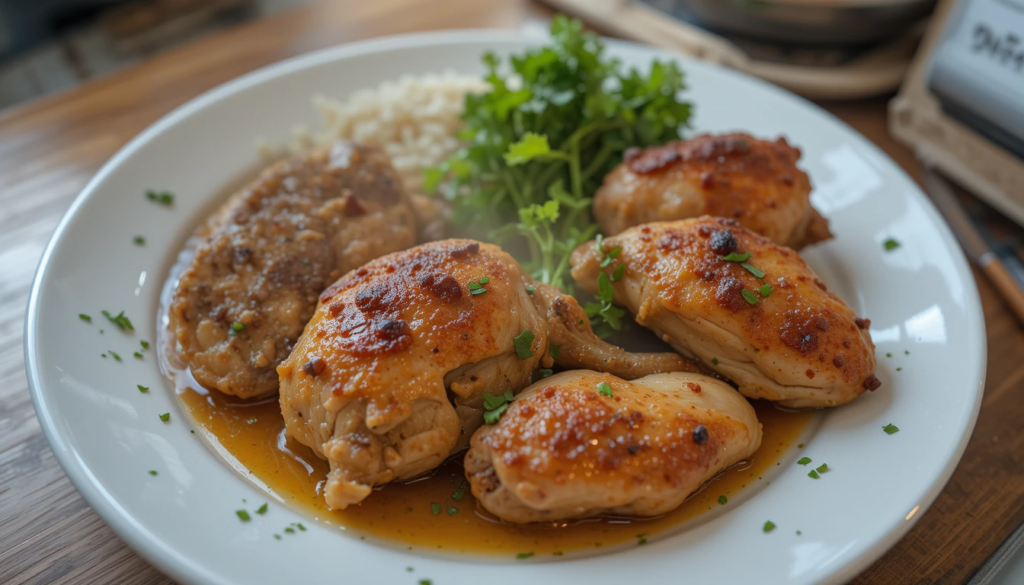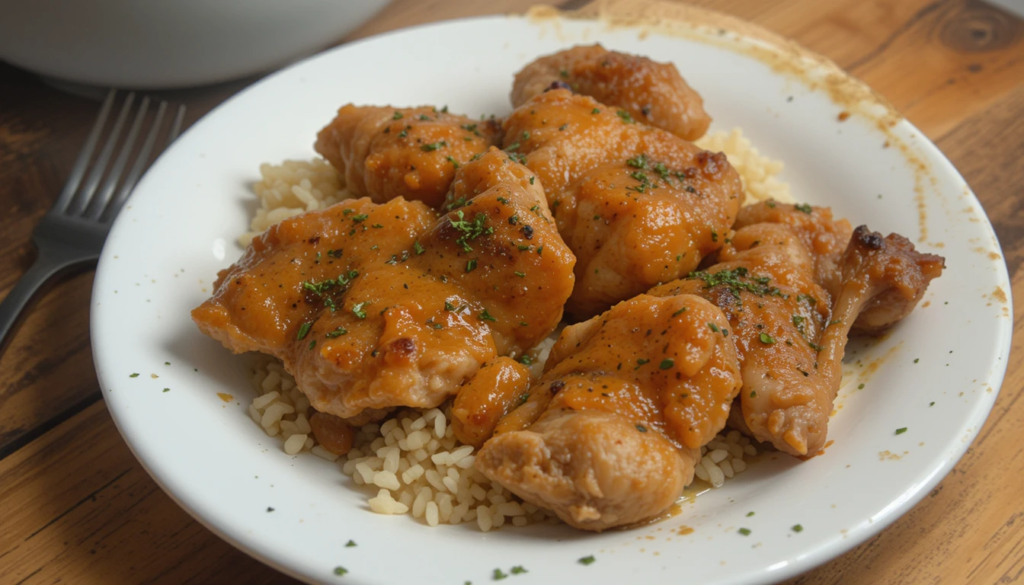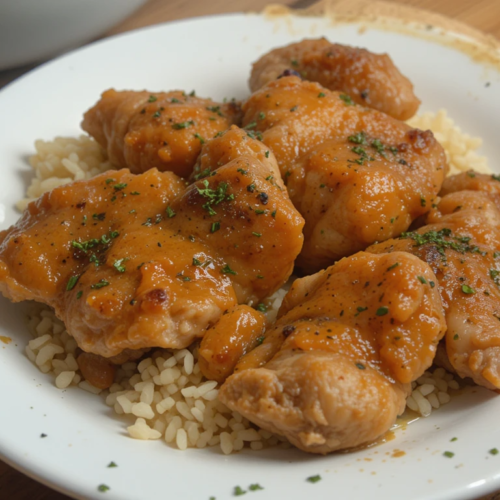What Is Forgotten Chicken?
Forgotten chicken is a deliciously tender and flavorful dish made with chicken breasts, cream of chicken soup, sour cream, and a blend of seasonings. This dish is cooked in a slow cooker, allowing the flavors to meld together and creating a rich, creamy sauce. The chicken is so tender that it can be easily shredded with a fork, making it a favorite for its melt-in-your-mouth texture.
Table of Contents
The Origin and Popularity of Forgotten Chicken
The origin of forgotten chicken is unclear, but it has gained popularity as a convenient and delicious slow cooker meal. The dish is loved for its ease of preparation and the use of readily available ingredients. Forgotten chicken’s tender texture and rich flavor have contributed to its enduring popularity, making it a staple in many households. Its versatility and delicious taste have made it a go-to recipe for busy weeknights and family gatherings.
Essential Ingredients for Forgotten Chicken Recipe

Chicken Breasts: The Star Ingredient
Chicken breasts are the star ingredient in this recipe. Opt for boneless, skinless chicken breasts for ease of preparation and even cooking. Ensure the chicken breasts are fresh and of high quality for the best results.
| Ingredient | Quantity |
|---|---|
| Boneless, skinless chicken breasts | 4 pieces (about 1.5 lbs or 680g) |
Cream of Chicken Soup: Adding Creaminess
Cream of chicken soup adds creaminess and a rich, savory flavor to the dish. It helps create a velvety sauce that coats the chicken and enhances the overall taste.
| Ingredient | Quantity |
|---|---|
| Cream of chicken soup, condensed | 1 can (10.5 oz or 298g) |
Sour Cream: Enhancing Richness
Sour cream enhances the richness and creaminess of the sauce. It adds a tangy note that complements the other ingredients and creates a smooth, velvety texture.
| Ingredient | Quantity |
|---|---|
| Sour cream | 1 cup (240g) |
Seasonings: Boosting the Flavor
A blend of seasonings boosts the flavor of the dish. Common seasonings include:
- Salt: Enhances the overall flavor.
- Black Pepper: Adds a subtle kick.
- Garlic Powder: Provides a savory, garlicky note.
- Onion Powder: Adds a mild onion flavor that complements the other ingredients.
- Paprika: Provides a mild, slightly sweet, and smoky flavor.
| Ingredient | Quantity |
|---|---|
| Salt | 1 tsp |
| Black Pepper | 1/2 tsp |
| Garlic Powder | 1 tsp |
| Onion Powder | 1 tsp |
| Paprika | 1 tsp |
Optional Add-Ins: Vegetables and Cheese
Optional add-ins like vegetables and cheese can enhance the flavor and texture of the dish. Common add-ins include:
- Onions: Add a slightly pungent and savory flavor to the dish.
- Bell Peppers: Provide a crunchy and slightly sweet element.
- Cheese: Adds a creamy and gooey texture that complements the rich sauce.
| Ingredient | Quantity |
|---|---|
| Onions, chopped (optional) | 1 medium onion |
| Bell peppers, sliced (optional) | 1 medium bell pepper |
| Shredded cheese (e.g., cheddar or mozzarella, optional) | 1 cup (113g) |
Step-by-Step Forgotten Chicken Recipe
Now that you have all the essential ingredients, let’s dive into the step-by-step forgotten chicken recipe. This guide will walk you through each stage of the process, ensuring you achieve a deliciously tender and flavorful dish every time.
Preparing the Ingredients
| Step | Instruction |
|---|---|
| 1 | Season the Chicken: Pat the chicken breasts dry with a paper towel. Season both sides of the chicken breasts with salt, black pepper, garlic powder, onion powder, and paprika. Ensure the chicken is evenly coated with the seasonings. |
| 2 | Prepare the Vegetables (Optional): If using, chop the onions and slice the bell peppers. This will add extra flavor and texture to the dish. |
Mixing the Sauce
| Step | Instruction |
|---|---|
| 1 | Combine Soup and Sour Cream: In a mixing bowl, combine the condensed cream of chicken soup and sour cream. Mix well to ensure the ingredients are fully incorporated and the mixture is smooth. |
| 2 | Add Seasonings: Stir in any additional seasonings you prefer, such as more garlic powder or onion powder, to enhance the flavor of the sauce. |
Assembling the Dish
| Step | Instruction |
|---|---|
| 1 | Place Chicken in Slow Cooker: Arrange the seasoned chicken breasts in the slow cooker. Ensure the chicken is evenly distributed and not overlapping too much. |
| 2 | Add Vegetables (Optional): If using, scatter the chopped onions and sliced bell peppers over the chicken breasts in the slow cooker. |
| 3 | Pour the Sauce: Evenly pour the soup and sour cream mixture over the chicken breasts and vegetables in the slow cooker. Ensure the sauce covers the chicken and vegetables completely. |
Slow Cooking the Chicken
| Step | Instruction |
|---|---|
| 1 | Set the Slow Cooker: Cover the slow cooker with the lid and set it to cook on low heat for 6-8 hours. This allows the chicken to cook slowly and evenly, becoming tender and flavorful. |
| 2 | Check for Doneness: Ensure the chicken is cooked through and the internal temperature reaches 165°F (74°C). Use a meat thermometer to check the temperature if needed. |
Serving Suggestions
| Step | Instruction |
|---|---|
| 1 | Shred the Chicken: Once the chicken is cooked, carefully remove it from the slow cooker and place it on a plate. Use two forks to shred the chicken easily. |
| 2 | Return to Slow Cooker: Place the shredded chicken back into the slow cooker and mix it with the sauce. Ensure the chicken is well coated with the creamy sauce. |
| 3 | Add Cheese (Optional): If using, sprinkle the shredded cheese over the chicken and sauce in the slow cooker. Stir gently to combine, allowing the cheese to melt and create a gooey texture. |
| 4 | Serve: Serve the forgotten chicken hot, over rice, pasta, or mashed potatoes. You can also serve it with a side of steamed vegetables or a fresh salad for a complete meal. |
By following these detailed steps, you’ll be well on your way to creating a deliciously tender and flavorful forgotten chicken dish.
Tips for Making the Perfect Forgotten Chicken

Creating the perfect forgotten chicken involves more than just following a recipe. Here are some essential tips to help you achieve the best results every time:
Choosing the Right Chicken Breasts
- Freshness Matters: Ensure the chicken breasts are fresh and of high quality. Look for plump, firm breasts with a pinkish hue.
- Size: Choose chicken breasts that are similar in size to ensure even cooking. If the breasts are particularly large, consider cutting them into smaller, more manageable pieces.
- Organic: Opt for organic or free-range chicken for better flavor and ethical considerations.
Achieving the Perfect Texture
- Avoid Overcooking: Be careful not to overcook the chicken, as this can result in a dry and tough texture. Cook the chicken on low heat in the slow cooker for the recommended time to ensure it stays tender and juicy.
- Check Temperature: Use a meat thermometer to check the internal temperature of the chicken. This ensures the chicken is cooked through without becoming overcooked.
Enhancing the Flavor
- Quality Ingredients: Use high-quality ingredients for the best flavor. Opt for full-fat sour cream and a trusted brand of cream of chicken soup for a rich and creamy sauce.
- Extra Seasoning: Don’t be afraid to add extra seasonings to the sauce to enhance the flavor. You can always adjust the seasoning if needed to achieve your desired taste.
Adding Extra Touches
- Garnish: Add a touch of elegance to your dish with a garnish of fresh parsley or a sprinkle of paprika. This enhances the visual appeal and adds a finishing touch.
- Presentation: Use an attractive serving dish to present your forgotten chicken. Arrange the shredded chicken neatly on the dish for an eye-catching presentation.
Variations of the Forgotten Chicken Recipe
One of the best things about making forgotten chicken at home is the ability to customize the recipe to suit your tastes or dietary needs. Here are some popular variations to try:
Adding Different Proteins
- Chicken Thighs: Substitute the chicken breasts with boneless, skinless chicken thighs for a more tender and flavorful option. Chicken thighs have a higher fat content, which adds extra richness to the dish.
- Turkey Breast: Use turkey breast instead of chicken for a leaner protein option. Turkey breast provides a mild and tender texture that pairs well with the creamy sauce.
- Pork Tenderloin: Incorporate pork tenderloin for a unique twist. Pork tenderloin provides a rich and savory flavor that complements the creamy sauce.
Incorporating Other Flavors
- Italian Seasoning: Add a pinch of Italian seasoning to the sauce for a blend of herbs like oregano, basil, and thyme. This adds a delicious Italian flavor to the dish.
- Cajun Seasoning: Incorporate Cajun seasoning for a spicy and flavorful kick. Cajun seasoning adds a unique blend of spices that complements the chicken.
- Lemon Zest: Add grated lemon zest to the sauce for a bright, citrusy flavor that enhances the overall taste of the dish.
Experimenting with Toppings
- Crispy Bacon: Top the forgotten chicken with crispy bacon bits for an extra layer of flavor and texture. Bacon adds a smoky and savory note that complements the creamy sauce.
- Caramelized Onions: Add caramelized onions to the dish for a sweet and savory element. Caramelized onions provide a rich, caramel-like flavor that enhances the overall taste.
- Sautéed Mushrooms: Incorporate sautéed mushrooms for an earthy and savory note. Mushrooms add depth and a unique texture to the dish.
Frequently Asked Questions (FAQs)
How Long Does Forgotten Chicken Last?
Forgotten chicken can last for up to 3-4 days when stored properly in the refrigerator. Ensure the chicken is stored in an airtight container to maintain freshness and prevent it from drying out. Reheat the chicken gently in the oven or on the stovetop to restore its tender texture and rich flavor.
Can I Use Chicken Thighs Instead of Breasts?
Yes, you can use chicken thighs instead of breasts for this recipe. Chicken thighs have a higher fat content, which adds extra richness and tenderness to the dish. Ensure the chicken thighs are boneless and skinless for ease of preparation. Keep in mind that the cooking time may vary, so adjust the slow cooker time accordingly and use a meat thermometer to ensure the chicken is cooked through.
What If My Chicken Is Too Dry?
If your forgotten chicken turns out too dry, it may be due to overcooking or not using enough liquid in the sauce. Here are some tips to achieve the perfect texture:
- Add More Liquid: If the chicken is too dry, try adding a small amount of additional liquid, such as chicken broth or cream, to the sauce. This helps increase the moisture content and prevents the chicken from becoming too dry.
- Avoid Overcooking: Be careful not to overcook the chicken, as this can result in a dry and tough texture. Cook the chicken on low heat in the slow cooker for the recommended time to ensure it stays tender and juicy.
- Check Temperature: Use a meat thermometer to check the internal temperature of the chicken. This ensures the chicken is cooked through without becoming overcooked.
Can I Make Forgotten Chicken Ahead of Time?
You can prepare the forgotten chicken ahead of time by mixing the sauce and seasoning the chicken breasts. Store them in the refrigerator until ready to assemble and cook in the slow cooker. However, it’s best to cook the chicken just before serving to ensure the best texture and freshness. If you must cook the chicken ahead of time, reheat it gently in the oven or on the stovetop to restore its tender texture and rich flavor.
How Do I Store Leftover Forgotten Chicken?
Store leftover forgotten chicken in an airtight container in the refrigerator. Consume it within 3-4 days for the best flavor and freshness. To maintain the chicken’s tender texture, reheat it gently in the oven or on the stovetop with a small amount of added liquid, such as chicken broth or cream. This helps restore the moisture content and prevents the chicken from becoming too dry.
What Are Some Health Benefits of Forgotten Chicken?
Forgotten chicken offers several health benefits due to its ingredients:
- Protein: Chicken breasts are an excellent source of lean protein, which is essential for muscle repair and growth.
- Vitamins and Minerals: Chicken contains various vitamins and minerals, such as vitamin B6, niacin, and phosphorus, which support overall health.
- Low in Fat: Chicken breasts are naturally low in fat, making them a healthier option compared to other cuts of meat.
- Versatility: Forgotten chicken can be incorporated into a variety of meals, making it easy to include in a balanced diet.
By addressing these common questions, you’ll be well-equipped to handle any challenges that may arise during your forgotten chicken cooking adventures.
Conclusion
Mastering the forgotten chicken recipe allows you to create a deliciously tender and flavorful dish in the comfort of your own home. By understanding the essential ingredients, following a step-by-step recipe, and applying helpful tips, you can achieve a perfectly cooked and richly flavored forgotten chicken that is sure to be a hit with anyone who tries it.
Enjoy Your Delicious Forgotten Chicken!
Now that you have a comprehensive understanding of the forgotten chicken recipe, it’s time to get cooking! Experiment with different variations, share your creations with loved ones, and enjoy the fruits of your labor. Remember, practice makes perfect, so don’t be discouraged if your first attempt isn’t exactly as you envisioned. With each try, you’ll gain more experience and confidence in your forgotten chicken cooking skills.
Happy cooking, and enjoy your delicious, tender forgotten chicken!

forgotten chicken recipe
Ingredients
- 1½ cups long-grain white rice uncooked
- 1 10.5 oz can cream of mushroom soup (or cream of chicken/celery)
- 1 10.5 oz can water (use the soup can to measure)
- 1 1 oz packet dry onion soup mix (or 2 tbsp homemade seasoning*)
- 6 bone-in skin-on chicken thighs (or 4 breasts)
- Salt and pepper to taste
- Optional: 1 cup frozen peas ½ cup sliced mushrooms, or fresh herbs (parsley/thyme)
- Homemade seasoning mix: 1 tbsp dried minced onion 1 tsp garlic powder, ½ tsp paprika, ½ tsp salt, ¼ tsp celery seed.
Instructions
- Preheat oven to 325°F (165°C).
- In a 9×13-inch baking dish, spread rice evenly.
- In a bowl, mix cream of mushroom soup, water, and dry onion soup mix. Pour over rice.
- Arrange chicken on top of the rice mixture. Season chicken lightly with salt and pepper.
- Cover tightly with foil and bake for 2–2½ hours, until chicken is fall-off-the-bone tender and rice is cooked.
- Uncover, add peas/mushrooms (if using), and bake 10 more minutes to thicken. Garnish with herbs.
Video
Notes
- Gluten-free: Use GF cream of mushroom soup and GF onion soup seasoning.
- Vegetarian twist: Swap chicken for chickpeas and use veggie broth instead of water.
- Crispy skin: Remove foil for the last 15–20 minutes to brown the chicken.
- Shortcut: Use boneless chicken and reduce bake time to 1½ hours.
